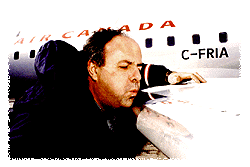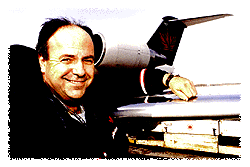 |
 |
 |
|
|||
|
The Truth About Airplane De-Icing
It's five in the morning and with the wind, it's 30 degrees below zero. Grainy snow that feels like desert sand is whipping around my face. This is a normal morning for Montreal, where winter temperatures rarely rise above freezing and snowfall averages about a hundred inches per year. Montreal, like other cities with severe winters, is a tough place for planes to fly in and out of. On the tarmac, near the runway, a long row of Air Canada planes is silhouetted against the snow. Andre Marois will inspect every one of them for ice, frost or snow -- what in de-icing jargon is called "contamination."
We're standing on a hydraulic platform on the front of Marois' truck looking across the wing of an Airbus bound for L.A. As I shiver, Marois climbs onto the wing, pulls off his glove, scratches the surface and inspects his fingernails for frost. No high-tech tool. Sometimes he puts his mouth close to the metal body and blows the snow.
No contamination at all is exactly what the FAA demands. The plane's body has to be smooth...especially the wings. Any ice, snow or frost creates drag and make it hard for the plane to take off. Marois' next step is to tell the captain, the person who is ultimately responsible for de-icing decisions, what's recommended. I follow Marois up slippery metal stairs and into the cockpit.
Aeromag is the de-icing center, where they treat planes with two types of glycol solutions -- something like car antifreeze. At the de-icing center there are explosions and clouds of steam over a row of Delta, American and Northwest aircraft. Huge yellow cranes circle the planes from high up in what looks like cherry pickers. Workers in yellow firefighter suits and masks have pressure hoses and blast Boeing 747's with up to 1200 gallons of 180 degree liquid.
Andre Provost is head of the team of "icemen" (and women). I squeeze in behind his seat in this one-person capsule. We rise 55 feet. Looking down, big trucks look like toys. Provost points the 50-foot boom like a long yellow finger at the plane. The boom has two hoses on its end and Provost controls the boom and hoses with a joystick, like a video game.
We're over the wing spraying hard. And when we move in close over the plane the engine blast shakes the little cab like the earthquake ride at Universal Studios. It's dangerous but we have to go in close to spray the plane. At the same time we have to stay 100 feet behind the engine or we'll be blown over by the force. We're up over the aircraft and the glycol-based liquid is pouring down over the tail of a Vancouver-bound. Provost is in constant contact with the ground and the tower, concentrating completely on his job.
When the plane is finished there will be another scratch test. If that's okay, it's free to leave. The goal is to de-ice a plane within 15 minutes of take off. Each captain has a chart of how long the de-icing lasts at different temperatures, so if there is a delay, it's up to the captain to come back and redo the de-icing. There is discussion in the aircraft community about a self-defrosting process: putting heating wires on the body of the plane to melt ice like a defroster in the rear windows of cars. But for now, passengers and crew must rely on the fine engineering that has gone into creating the human eye and the thousands of nerve endings in human fingers of north America's icemen. At Dorval Airport in Montreal, I'm Judith Ritter for The Savvy Traveler. |
 | American Public Media Home | Search | How to Listen ©2004 American Public Media | Terms of Use | Privacy Policy |


